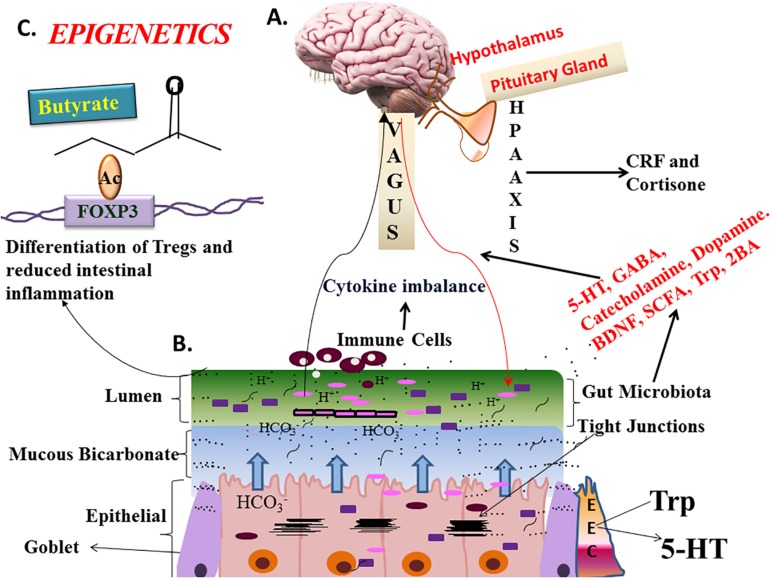FIGURE 2.
State-of the–science-Gut-Brain-Bidirectional Axis (GBM). Three ways microbes communicate with GBM: neurobiochemical, neuroendocrinal, and neuroimmune mechanisms. Microbial sps can modulate hypothalamus-pituitary-adrenal gland (HPA) axis, by affecting corticotrophin releasing factor (CRF), and cortisone levels which can subsequently affect intestinal permeability and cause hypersensitivity. Neuroactive molecules like γ-aminobutyric acid (GABA), 5-HT, norepinephrine, and dopamine are produced independently by bacteria or through digestion of other food sources. Lactobacillus subspecies, Candida, Streptococcus, E. coli, and Enterococcus can make 5HT which affects sleep, appetite, mood, and cognition (Liu and Zhu, 2018). Clostridiales regulate synthesis and release of 5-HT by making tryptophan available (Martin et al., 2018) for its synthesis. Vagus nerve is the major connection between microbiome and gut, is imperative for GBM-axis. Microbial metabolites like short chain fatty acids, bile acids, and tryptophan can communicate between gut and brain directly or through vagal/spinal highways. Stress, dietary changes and microbiome can lead to cytokines imbalance and increases the risk of intestinal inflammation, IBD, and allergies, etc. Gut microbiota made metabolites like butyrate have epigenetic effect on FOXP3 (forkhead box P3) promoter of T-regs (Furusawa et al., 2013). Prebiotics like fructo-oligosaccharides and galacto-oligosaccharides increase BDNF, serotonin, GABAb receptor levels while reducing cortisone and L-Trp, hence have anti-anxiety and anti-depressant effect. Prebiotics and probiotics regulate the capacity of intestinal microbiota, preserve the integrity of the intestinal barrier (enteroendocrine cells), prevent bacterial translocation and regulate local inflammatory reaction through the intestinal related immune system. BDNF, Brain-derived Neurotrophic Factor; 5-HT, Serotonin; Trp, Tryptophan; SCFA, Short-chain fatty acid. (A) Showing human brain with detailed picture of hypothalamus and pituitary gland (B). Showing the gastric mucosa lined by epithelial, goblet, and enterochromaffin cells (EEC), gastric mucosa is also showing bicarbonate buffer and lumen which has most of the microbiota (from Wikipedia) (C). Showing the epigenetic effect of butyrate on FOXP3 promoter.

